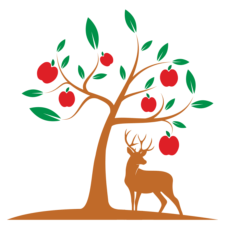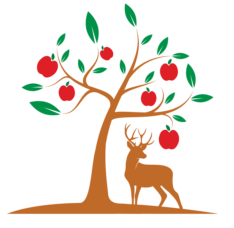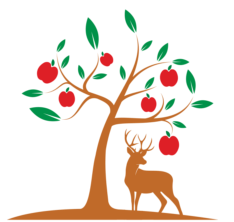(906) 282-3158
Iron Mountain, MI
Home | About Us | Contact Us | Order Trees | Our Products | Tips
N3700 Motts Landing Dr. Iron Mountain, MI 49801
Phone: (906) 282-3158 | Email: greg@n40wildapples.com
Website by North Country Website Design.
North Forty
Wild Apple Trees
North Forty
Wild Apple Trees
Our Products
Superior Quality - Affordable Price
North Forty Wild Apple Trees are a low cost alternative to grafted apple trees to create quality wildlife habitat on your hunting or recreational property. Starting at only $7.00 per tree for seedlings, North Forty trees are an affordable way to attract and hold wildlife to your property for generations. Whether your goal is to increase hunting success, add value to your recreational property, or simply to watch wildlife interact in a natural setting, North Forty Wild Apple Trees are a great addition to your landscape. • Three-year old transplants are 42" - 60" tall. • Two-year old transplants are 24" - 42" tall. • Seedlings are 12" - 24" tall. Our wild apple trees are grown from seeds hand-collected from over 650 wild apple trees managed by North Forty to produce genetically diverse seed stock. Our trees are grown outdoors where they are fully exposed to winter conditions in USDA Zone 4a frigid climate conditions to ensure hardiness. With proper sunlight, nutrients and water North Forty Wild Apple Trees will begin to bear fruit in 6-10 years. These are full-sized standard trees that will grow to 30 feet tall. A healthy tree will live 60-80 years and a mature tree can produce up to 20 bushels of fruit in a season. North Forty Wild Apple Trees are not grafted and are intended for wildlife plantings. Although they may produce an excellent apple for eating or baking, they should not be relied upon for that purpose.Eco-Friendly Packaging - No Hassle Shipping
North Forty Wild Apple Trees are packaged and shipped bare-root about May 1 via FedEx Ground Delivery to any location in the 48 contiguous U.S. states. Three-year old trees are packaged and sold in multiples of 6 trees; two-year old trees are packaged and sold in bundles of 5 trees per bundle; and, seedlings are packaged and sold by the dozen. The tree roots are dipped in rooting gel before packaging; then moisture packed with recycled newsprint and wrapped in degradable stretch wrap to keep the roots moist during shipping. Trees should be planted as soon as possible when received. If you're not able to plant the trees immediately, simply pour water into the top of the moisture pack and store in a cool, dark place. It's best to leave the trees bundled in the moisture pack until you are ready to plant. They can be stored for several days, but the sooner they are planted the better they will do.Why Choose Wild Apples?
Wild apple trees are better suited for wildlife plantings and habitat improvement. A wild apple tree will grow to become a full-sized standard tree that is physically larger and stronger than its semi-dwarf cousins found at most retail stores. A wild tree's larger size makes it better able to stand up to the abuse that animals and the elements will inflict on it in the wild. Random cross-pollination of wild apple tress cause genetic vagaries inherent in apple trees grown from seed that make the fruit from each wild apple tree uniquely different and unpredictable. This natural genetic diversity is undesirable for commercial apple growers, but provides a more resilient tree that is better adapted to survive in the wild. A grafted apple tree is genetically identical to its ancestor that the original graft was taken from and has stopped adapting natural defenses to resist its natural enemies. Unlike a grafted tree, wild apple trees continue to genetically coevolve with the natural viruses, bacteria and fungi that prey upon apple trees making the wild apple tree better able to survive the attacks by its natural enemies. Wild apple trees get their name because they are grown from seed rather than grafted to root stock and usually grow in uncultivated ground or fields. Wild apple trees have flourished unattended in North America for nearly 400 years. The earliest record of the introduction of wild apple trees to North America occurs south of Boston, Massachusetts in 1635 when Reverend William Blaxton planted an orchard entirely from seed brought from England. Following that meager introduction, American settlers played a crucial role in expanding the wild apple's presence westward into the Ohio River Valley in the 18th and 19th centuries aided by the eccentricity of Jonathan Chapman (better known as Johnny Appleseed). Today, the presence of wild apple trees growing across the U.S. is evidence of their ability to thrive unattended when introduced in the wild for habitat improvement.





Wild Apple Trees
North Forty
Iron Mountain, MI
Home | About | Contact | Order Trees | Our Products
N3700 Motts Landing Dr. Iron Mountain, MI 49801
Phone: (906) 282-3158
Email: greg@n40wildapples.com
Website by North Country Website Design.
North Forty
Wild Apple Trees
Our Products
Superior Quality - Affordable
Price
North Forty Wild Apple Trees are a low cost alternative to grafted apple trees to create quality wildlife habitat on your hunting or recreational property. Starting at only $7.00 per tree for seedlings, North Forty trees are an affordable way to attract and hold wildlife to your property for generations. Whether your goal is to increase hunting success, add value to your recreational property, or simply to watch wildlife interact in a natural setting, North Forty Wild Apple Trees are a great addition to your landscape. • Three-year old transplants are 42" - 60" tall. • Two-year old transplants are 24" - 42" tall. • Seedlings are 12" - 24" tall. Our wild apple trees are grown from seeds hand- collected from over 650 wild apple trees managed by North Forty to produce genetically diverse seed stock. Our trees are grown outdoors where they are fully exposed to winter conditions in USDA Zone 4a frigid climate conditions to ensure hardiness. With proper sunlight, nutrients and water North Forty Wild Apple Trees will begin to bear fruit in 6-10 years. These are full-sized standard trees that will grow to 30 feet tall. A healthy tree will live 60-80 years and a mature tree can produce up to 20 bushels of fruit in a season. North Forty Wild Apple Trees are not grafted and are intended for wildlife plantings. Although they may produce an excellent apple for eating or baking, they should not be relied upon for that purpose.Eco-Friendly Packaging - No
Hassle Shipping
North Forty Wild Apple Trees are packaged and shipped bare-root about May 1 via FedEx Ground Delivery to any location in the 48 contiguous U.S. states. Three-year old trees are packaged and sold in multiples of 6 trees; two-year old trees are packaged and sold in bundles of 5 trees per bundle; and, seedlings are packaged and sold by the dozen. The tree roots are dipped in rooting gel before packaging; then moisture packed with recycled newsprint and wrapped in degradable stretch wrap to keep the roots moist during shipping. Trees should be planted as soon as possible when received. If you're not able to plant the trees immediately, simply pour water into the top of the moisture pack and store in a cool, dark place. It's best to leave the trees bundled in the moisture pack until you are ready to plant. They can be stored for several days, but the sooner they are planted the better they will do.Why Choose Wild Apples?
Wild apple trees are better suited for wildlife plantings and habitat improvement. A wild apple tree will grow to become a full-sized standard tree that is physically larger and stronger than its semi-dwarf cousins found at most retail stores. A wild tree's larger size makes it better able to stand up to the abuse that animals and the elements will inflict on it in the wild. Random cross-pollination of wild apple tress cause genetic vagaries inherent in apple trees grown from seed that make the fruit from each wild apple tree uniquely different and unpredictable. This natural genetic diversity is undesirable for commercial apple growers, but provides a more resilient tree that is better adapted to survive in the wild. A grafted apple tree is genetically identical to its ancestor that the original graft was taken from and has stopped adapting natural defenses to resist its natural enemies. Unlike a grafted tree, wild apple trees continue to genetically coevolve with the natural viruses, bacteria and fungi that prey upon apple trees making the wild apple tree better able to survive the attacks by its natural enemies. Wild apple trees get their name because they are grown from seed rather than grafted to root stock and usually grow in uncultivated ground or fields. Wild apple trees have flourished unattended in North America for nearly 400 years. The earliest record of the introduction of wild apple trees to North America occurs south of Boston, Massachusetts in 1635 when Reverend William Blaxton planted an orchard entirely from seed brought from England. Following that meager introduction, American settlers played a crucial role in expanding the wild apple's presence westward into the Ohio River Valley in the 18th and 19th centuries aided by the eccentricity of Jonathan Chapman (better known as Johnny Appleseed). Today, the presence of wild apple trees growing across the U.S. is evidence of their ability to thrive unattended when introduced in the wild for habitat improvement.















